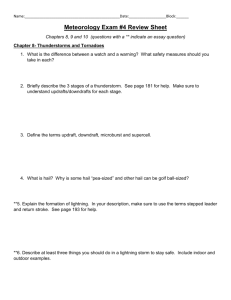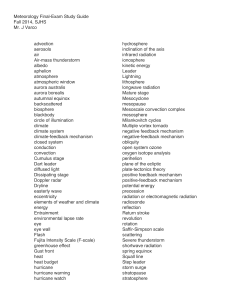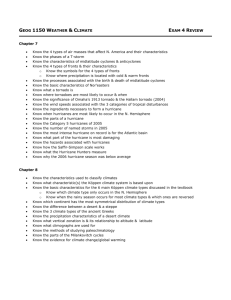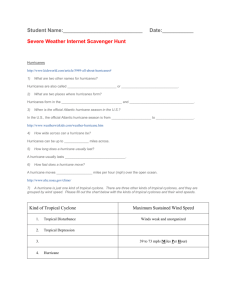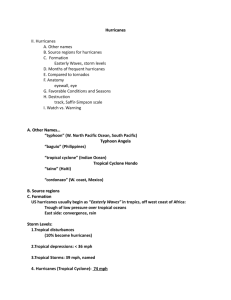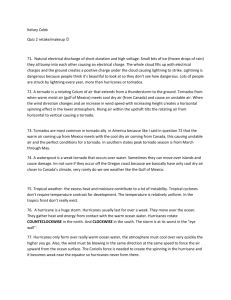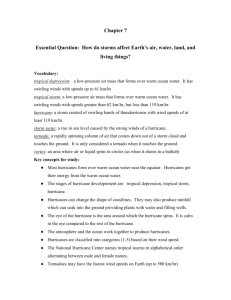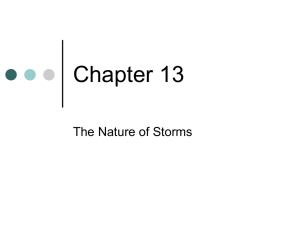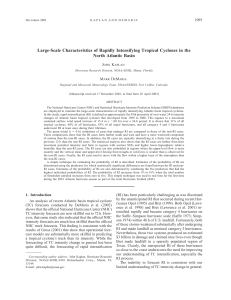Earth`s Atmosphere Study Guide
advertisement
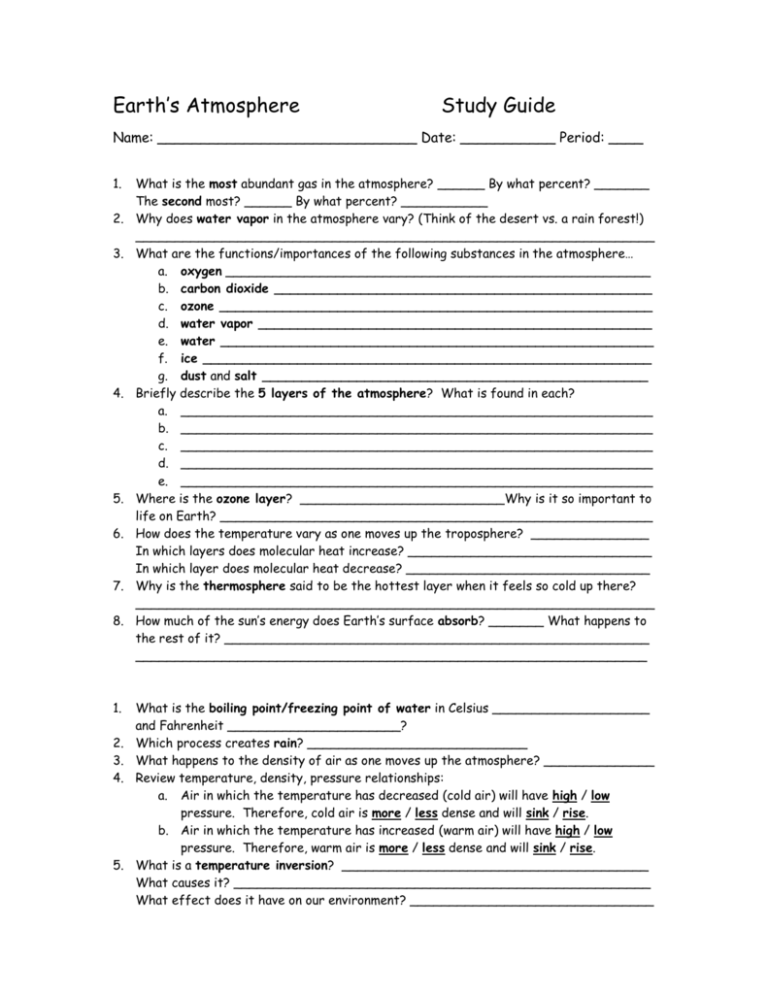
Earth’s Atmosphere Study Guide Name: ______________________________ Date: ___________ Period: ____ 1. 2. 3. 4. 5. 6. 7. 8. 1. 2. 3. 4. 5. What is the most abundant gas in the atmosphere? ______ By what percent? _______ The second most? ______ By what percent? ___________ Why does water vapor in the atmosphere vary? (Think of the desert vs. a rain forest!) __________________________________________________________________ What are the functions/importances of the following substances in the atmosphere… a. oxygen ______________________________________________________ b. carbon dioxide ________________________________________________ c. ozone _______________________________________________________ d. water vapor __________________________________________________ e. water _______________________________________________________ f. ice _________________________________________________________ g. dust and salt _________________________________________________ Briefly describe the 5 layers of the atmosphere? What is found in each? a. ____________________________________________________________ b. ____________________________________________________________ c. ____________________________________________________________ d. ____________________________________________________________ e. ____________________________________________________________ Where is the ozone layer? __________________________Why is it so important to life on Earth? _______________________________________________________ How does the temperature vary as one moves up the troposphere? _______________ In which layers does molecular heat increase? _______________________________ In which layer does molecular heat decrease? _______________________________ Why is the thermosphere said to be the hottest layer when it feels so cold up there? __________________________________________________________________ How much of the sun’s energy does Earth’s surface absorb? _______ What happens to the rest of it? ______________________________________________________ _________________________________________________________________ What is the boiling point/freezing point of water in Celsius ____________________ and Fahrenheit ______________________? Which process creates rain? ____________________________ What happens to the density of air as one moves up the atmosphere? ______________ Review temperature, density, pressure relationships: a. Air in which the temperature has decreased (cold air) will have high / low pressure. Therefore, cold air is more / less dense and will sink / rise. b. Air in which the temperature has increased (warm air) will have high / low pressure. Therefore, warm air is more / less dense and will sink / rise. What is a temperature inversion? _______________________________________ What causes it? _____________________________________________________ What effect does it have on our environment? _______________________________ 6. How is wind formed? __________________________________________________ 7. What is dew point? ___________________________________________________ What does it indicate about the comfort of a particular place? __________________________________________________________________ 8. What is relative humidity? _____________________________________________ 9. How can relative humidity be determined? (Be able to calculate this.) __________________________________________________________________ 1. 2. 3. 4. 5. 6. 7. 8. 9. Explain the 3 ways clouds can form. (Briefly.) __________________________________________________________________ __________________________________________________________________ What is the lifted condensation level? __________________________________________________________________ What is orographic lifting? __________________________________________________________________ When a warm air mass and a cold air mass meet, which one rises? ________________ Why? _____________________________________________________________ How high are the following types of clouds – a. cirro- _________________ b. alto- __________________ c. strato- _________________ What do the following words mean in Latin – a. cirrus - _________________________ b. cumulus - ________________________ c. stratus - ________________________ d. nimbus - _________________________ Be able to recognize the shape and location of each of the 10 clouds in Fig 11-14. Which types of clouds indicate a. fair weather? _______________________________ b. An approaching front? _________________________ c. A strong storm? _____________________________ d. Constant rain or snow? _________________________ e. A cloud on the ground? _________________________ Be able to explain the water cycle using the terms evaporation, condensation, and precipitation. Know what each term means and where each process occurs. You should draw this below. 1. Know the following terms – (Write brief phrases!) a. meteorology - _____________________________________________ b. weather - ________________________________________________ c. climate - _________________________________________________ d. air mass - ________________________________________________ 2. Know the location and characteristics of the 5 major air masses that affect the weather of the USA. (See chart.) a. Continental tropical _________________________________________ 3. 4. 5. 6. b. Maritime tropical ___________________________________________ c. Continental polar ____________________________________________ d. Continental tropical __________________________________________ e. Arctic ____________________________________________________ Know the location and wind direction of the each of the global wind systems. Which wind system is responsible for the movement of weather across the USA? a. Polar easterlies - ____________________________________________ b. Prevailing westerlies - ________________________________________ c. Trade winds - ______________________________________________ What is a jet stream? _____________________________________________ Which direction do they come from? _______________________ Where are they located? _______________________ How fast do they move? ______________ What is the Intertropical Convergence Zone? _______________________________________________________________ How did it get its name? ____________________________________________ What is it also called? ______________________ What is usually missing in this zone? ________________ What are the horse latitudes? _______________________________________ Why are they called that? ___________________________________________ Describe the four types of fronts, identify the symbols for each, and describe the weather each causes. What happens to the temperature of an area after each passes? a. Cold - ____________________________________________________ b. Warm - ___________________________________________________ c. Stationary - _______________________________________________ d. Occluded - ________________________________________________ 8. Describe the 2 types of pressure systems. Recognize the symbol for each. What kind of weather is associated with each? a. High pressure - _____________________________________________ b. Low pressure - ______________________________________________ 7. 9. Know the data collected by the following weather instruments – a. thermometer ____________________ b. barometer ____________________ c. anemometer ____________________ d. hygrometer ____________________ e. ceilometer ____________________ 10. What type of data do radiosondes collect – in general and specifically? _______________________________________________________________ _______________________________________________________________ 11. What is radar? __________________________________________________ What does the word stand for? _______________________________________ For what is radar used to track? ______________________________________ 12. What is Doppler radar used for? _______________________________________________________________ 13. Know the terms – a. isobar - __________________________________________________ b. isotherm - ________________________________________________ 14. Be able to read a station model. (There will be a station model on your test!) 15. Know the difference between a digital and analog forecast. _______________________________________________________________ _______________________________________________________________ 1. Where do the majority of thunderstorms occur in the USA? _________________ 2. How, when, and where do the following types of thunderstorms form? Which types affect us here in the Piedmont? a. Air mass (mountain/orographic) _________________________________ b. Air mass (sea-breeze) ________________________________________ c. Frontal (cold) ______________________________________________ d. Frontal (warm) _____________________________________________ 3. List the 3 stages in the development of a thunderstorm in order. What occurs in each stage? a. _________________________________________________________ b. _________________________________________________________ c. _________________________________________________________ 4. Know the following terms – a. Thunderstorm ______________________________________________ b. Anvil _____________________________________________________ c. Supercell _________________________________________________ 5. What is lightning and how does it form? Use the terms stepped leader, return stroke, channel, and lightning in your answer. _______________________________________________________________ 6. Where is the safest place to be during a thunderstorm? ____________________ 7. Why do we hear lightning? What is the sound of lightning called? _______________________________________________________________ 8. What is a downburst? How does it differ from a tornado? _______________________________________________________________ 9. What are the 2 types of downbursts? Which type of downburst is the most deadly? _______________________________________________________________ 10. Why do floods occur? _______________________________________________________________ 1. Describe the 3 stages in the development of a tornado. a. _________________________________________________________ b. _________________________________________________________ c. _________________________________________________________ 2. Review the Enhanced Fujita Scale. What does it measure? __________________ When and how does it measure? ______________________________________ Which tornados are most common? __________ Which are least common? ______ Which are strongest, last the longest, and go the farthest? __________________ 3. Where is Tornado Alley? ___________________________________________ Which two air masses create the conditions for tornados to form in this area? _______________________________________________________________ 4. Where is the safest place to be in during a tornado? ______________________ 1. What is a tropical cyclone? __________________________________________ 2. List 3 names for tropical cyclones. What do we call them? _______________________________________________________________ 3. Where do cyclones derive their energy? ________________________________ What causes them to lose strength? ___________________________________ 4. Which direction do hurricanes spin and which way do they usually move in the N. hemisphere? _____________________________________________________ Which wind system pushes them back to the east? _________________________ 5. Do winds increase or decrease as a hurricane strengthens? __________________ What about pressure? ________________________ 6. Know the stages of hurricane development… Particularly, wind speed. a. Tropical disturbance _________________________________________ b. Tropical depression __________________________________________ c. Tropical storm ______________________________________________ d. Tropical cyclone (hurricane) ____________________________________ 7. Is a hurricane a high or low pressure system? What type of pressure is found in the eye of the hurricane? _______________ 8. Know the Saffir-Simpson Scale. What does it classify? ____________________ What are 3 characteristics of a hurricane it describes? _______________________________________________________________ What categories does it include? ___________ What is the wind speed for each category? _______________________________________________________ 9. What are the 3 most powerful hurricanes to hit the USA in recorded history? _______________________________________________________________ 10. Hurricane Hazards… a. Where are the strongest winds in a hurricane? _____________________ b. What is a storm surge? _______________________________________ c. What kills 9 out of 10 people who die in hurricanes? _________________ d. Which branch of NOAA tracks and forecasts hurricanes? _____________ 11. Where is the safest place to be during a hurricane? ________________________ .
